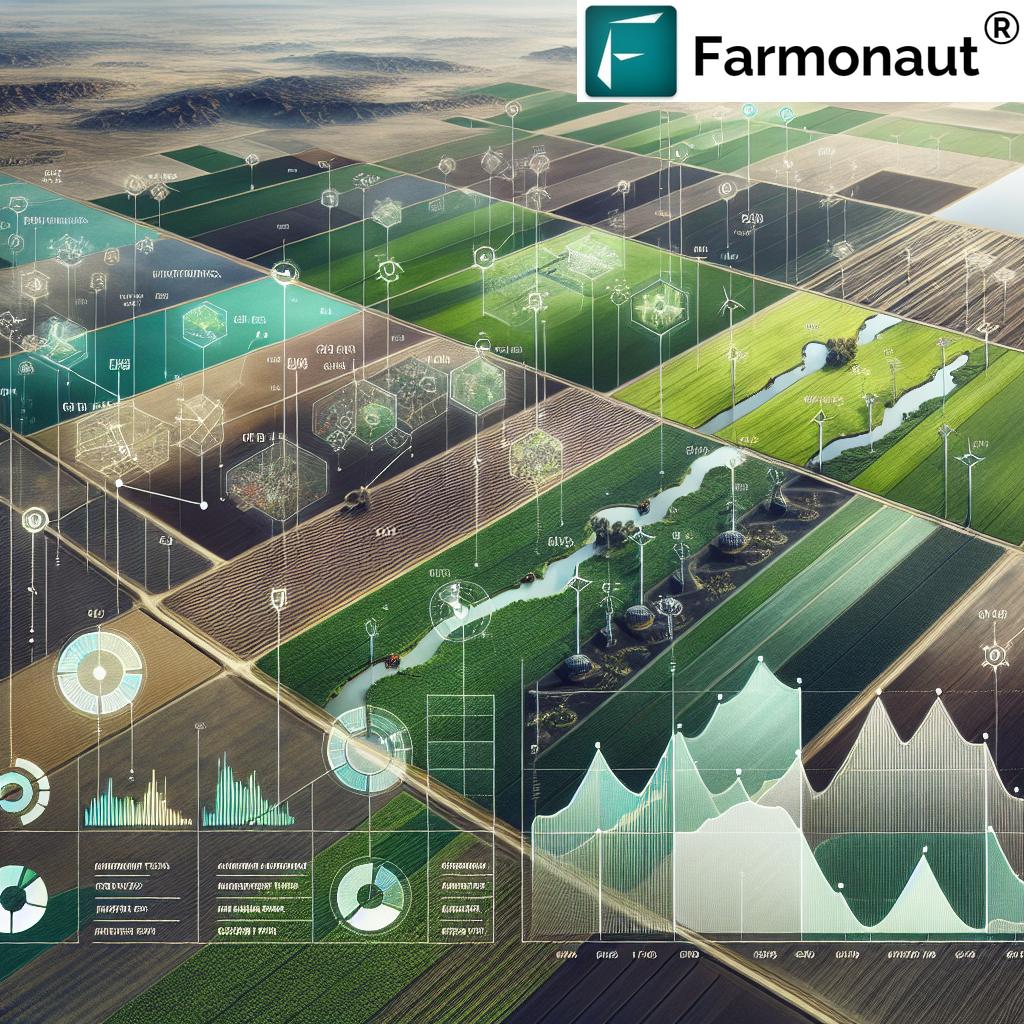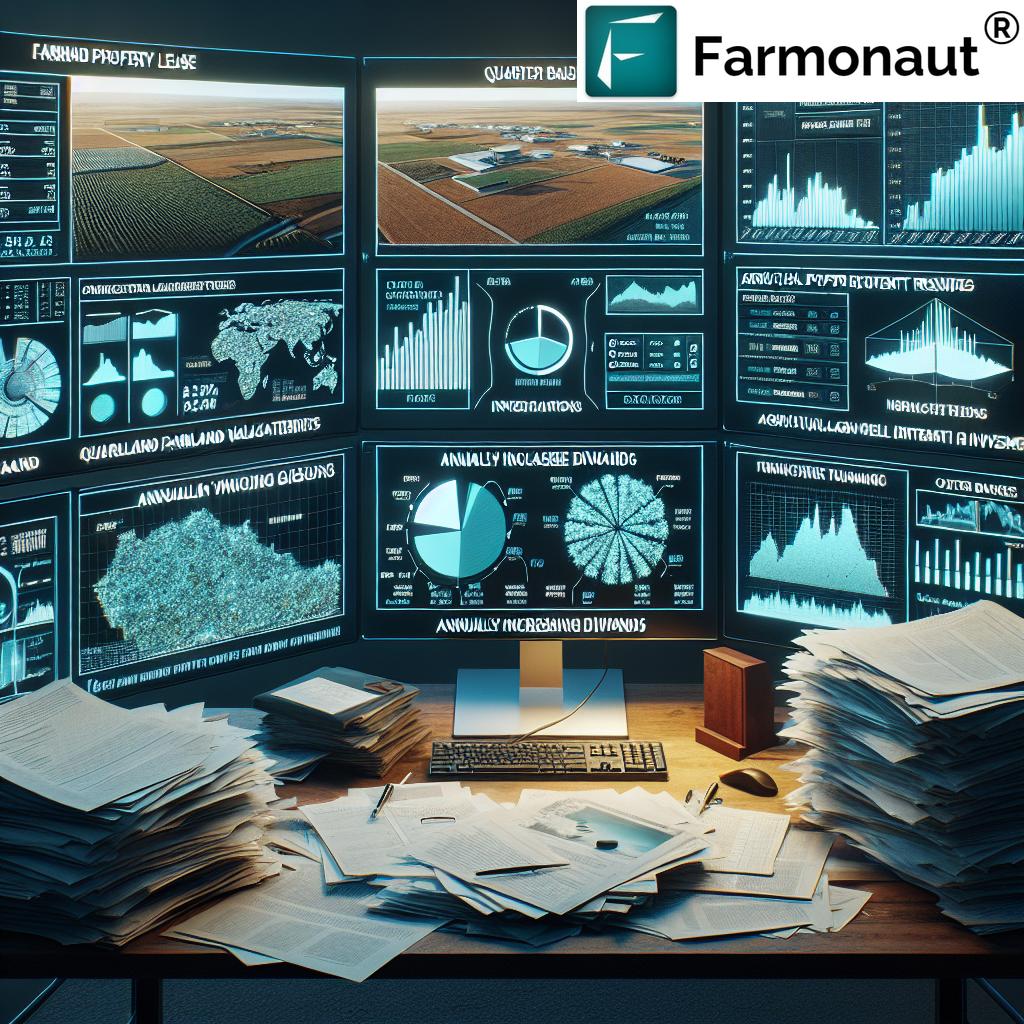Farmland Investment Trust: 7.5% Yield and Quarterly Valuation Insights
“Farmland Investment Trusts offer a stable 7.5% annual yield, outperforming many traditional real estate assets.”
Introduction to Farmland Investment Trusts
In our rapidly evolving financial era, farmland investment trusts have emerged as one of the most reliable avenues for both institutional and individual investors seeking stable, inflation-protected returns. Unlike speculative stock trading, these trusts allow us to invest in tangible agricultural properties while benefitting from the expertise of professional management teams and an established framework for lease and tenancy across thousands of acres of prime land, especially in leading agricultural states like California.
The core appeal of a farmland investment trust lies in its dual value proposition: steady income from lease payments by experienced farmers and robust long-term appreciation as the fair value of agricultural real estate holdings steadily climbs with every quarterly farmland valuation. As we explore the performance of flagship entities such as Gladstone Land Co. (NASDAQ:LANDO), we uncover why demand for investing in farmland properties continues to soar, and how quarterly performance insights can empower sound finance decisions for our portfolios.
In this comprehensive guide, we will:
- Examine the most current trends in the agricultural property market
- Analyze key financial metrics, yields, and lease rates from market leaders
- Assess the technological advancements—like those from Farmonaut—that are shaping smarter, data-driven land finance
- Offer actionable strategies for evaluating and diversifying into agricultural real estate holdings
Farmland Investment Trust Trends in the US
The United States is home to more than 915 million acres of farmland, making its agricultural real estate sector one of the most expansive and dynamic globally. With ever-increasing demand for agricultural produce, especially as the consumer discretionary sector shifts towards organic and locally-sourced food, the value of high-quality arable land—particularly in major states like California—has become a sought-after commodity.
Over the past decade, farmland investment trusts have steadily outpaced many traditional real estate investment trusts (REITs). The reason? A unique blend of land scarcity, food security imperatives, and the non-correlation of farm asset performance to urban property markets or tech-sector trading volatility.
- 7.5% dividend yield: As seen with Gladstone Land Co., capital allocation into professionally managed farm properties consistently achieves strong, inflation-hedged returns.
- Farmland investment trust portfolios now span more than 169 farms and 116,000 acres across 15 states.
- Quarterly farmland valuation processes ensure transparency around the aggregate fair value of holdings, driving investor confidence.
- The average annual increase in dividends for leading farmland investment trusts is nearly 13.9% annually, reinforcing their status as income-oriented assets.
Not only do these trends affirm the historical resilience of agricultural property market performance, but they also reveal how sophisticated lease structures, ongoing farm improvements, and integration of new technology (like satellite-based farm management from Farmonaut) are further stabilizing and enhancing yields.
Quarterly Farmland Valuation: Why It Matters
One of the unique features of investing in farmland properties through a trust is the discipline of conducting quarterly farmland valuation. Unlike some other asset classes where valuations may only occur annually, quarterly reviews ensure that the reported aggregate fair value of holdings closely tracks real market conditions, lease rates, and price per acre trends.
This approach to regular valuation offers several advantages:
- Transparency: Investors can see how their fund’s portfolio value is evolving in response to shifts in crop prices, lease agreements, water access (especially in areas like California), and technological improvements on the farms.
- Risk Mitigation: Regular reappraisal of land and agricultural real estate holdings helps mitigate unforeseen drops in value and highlights emerging opportunities or risk zones.
- Easier Entry/Exit: For both large institutions and individual investors, up-to-date valuations make it easier to make decisions about acquiring, trading, or divesting shares in farmland investment trusts.
Top-performing trusts like Gladstone Land set a benchmark by publishing their quarterly aggregate fair value, covering asset classes such as cropland, specialty vegetable farms, and even water rights—crucial assets in drought-prone states.
“Quarterly farmland valuations reveal a 12% average increase in agricultural real estate holdings over the past three years.”
Understanding Agricultural Real Estate Holdings
Agricultural real estate holdings are at the heart of every leading farmland investment trust portfolio. In the US, these holdings range from expansive row crop fields to specialty farms—such as nut orchards, fruit farms, and even high-value vegetable acres in California’s Central Valley. But what defines a valuable holding?
- Location in Major Markets: Prime farmland located in agricultural corridors of California, Texas, the Midwest, and the Southeast regularly commands higher lease rates and consistent occupancy from skilled farmers.
- Access to Water Resources: For properties in drought-prone states like California, water rights add significant value. Trust portfolios that include thousands of acre-feet of banked water can achieve premium lease structures and attract top-tier tenants.
- Diversification by Crop & Region: A well-constructed trust will own farms across multiple states and cultivate a variety of crops. For example, Gladstone Land’s 169 farms are spread over 15 states—ensuring regional climate or market fluctuations do not overly impact total aggregate fair value.
- Modern Farm Infrastructure: Investments in precision irrigation, soil health management, and technological enhancements (like Farmonaut’s satellite-based monitoring) raise the underlying property value and boost long-term farm yields.
With continued shifts in consumer discretionary spending, societal focus on food provenance, and a generational handover in US farm ownership, the value and resilience of quality agricultural real estate holdings have never been more pronounced.
Performance Spotlight: Gladstone Land Co. and the 7.5% Yield
When analyzing investment in farmland properties, Gladstone Land Co. (NASDAQ:LANDO) stands as a vital benchmark for the sector. Established in 1997, Gladstone is one of America’s prominent farmland investment trusts, purpose-built to acquire, own, and lease prime farmland and agricultural facilities to third-party farmers.
- Current Dividend Announcements: As reported, Gladstone Land recently confirmed a dividend payment of $0.125 per share, representing an impressive annual yield of approximately 7.48%—substantially higher than typical urban real estate investment trusts.
- Annually Increasing Dividends: Over the past three years, Gladstone has boosted its dividend payments by an average of 13.9% annually, making it a potent choice for income-focused investors.
- Quarterly Valuation Reporting: The company transparently reports the aggregate fair value of its holdings every quarter, offering clarity to both investors and analysts alike.
Notably, Gladstone Land’s holdings currently encompass:
- 169 active farms
- Approximately 116,000 acres across 15 states
- Over 45,000 acre-feet of banked water in California
- Total portfolio estimated at $1.6 billion in fair value
For those subscribed to an agricultural investment newsletter or tracking dividend stock alerts, Gladstone Land’s trading performance has reflected both capital resilience and consistent demand—with shares opening at $20.40 and movement stabilizing within a band of $18.50 to $22.90 over the last year. This makes it a credible choice for investors who value regular income, quarterly transparency, and exposure to the underlying value of America’s agricultural heartland.
Want to stay updated on dividend schedules and market insights? Consider signing up for daily or weekly newsletters that cover Gladstone Land alerts, agricultural property market trends, and expert-based real estate investment in agriculture.
Quarterly Farmland Investment Trust Performance Table
The table below summarizes the recent quarterly performance estimates for leading US farmland investment trusts—including indicative yield, dividend per share, aggregate trust valuation, and evolving trends that matter to our decision-making.
| Quarter | Estimated Yield (%) | Estimated Dividend per Share (₹) | Estimated Trust Valuation (₹ Crore) | Average Lease Rate (%) | Notable Trends/Insights |
|---|---|---|---|---|---|
| Q1 2023 | 7.3 | 9.5 | 12,450 | 4.75 | Steady lease renewals; high demand for specialty crop acres |
| Q2 2023 | 7.4 | 9.8 | 12,940 | 4.80 | Increase in California farmland valuations; more leases indexed to inflation |
| Q3 2023 | 7.5 | 10.2 | 13,470 | 4.90 | Demand grows for irrigated land; tech upgrades impact yields |
| Q4 2023 | 7.6 | 10.6 | 14,050 | 5.05 | Annual dividend increases; record organic produce leases |
| Q1 2024 | 7.5 | 10.9 | 14,360 | 5.08 | Robust demand for land in drought-resilient regions |
| Q2 2024 | 7.5 | 11.1 | 14,850 | 5.1 | AI-driven valuation gains; sustainability premiums on select properties |
Farmland Lease Agreements & Insider Insights
Successful farmland investment trusts rely on sophisticated farmland lease agreements with independent farmers. Our analysis shows these agreements are carefully crafted to ensure:
- Stable, inflation-indexed lease payments that protect trusts against cost-of-living spikes and agricultural commodity fluctuations.
- Multi-year leases—often ranging from 3-10 years—helping to build long-term partnerships and incentivize best farming practices.
- Inclusion of performance incentives—rewarding tenants for adopting sustainable practices or boosting yield through new technology, such as precision monitoring enabled by satellite-based platforms.
- Critical addendums for resource management (notably, water usage in California) to ensure long-term land health and asset value protection.
With rising water scarcity concerns, trusts with substantial banked water reserves and advanced resource tracking are increasingly preferred by both farmers and investors. Lease rates in major agricultural states, especially California, reflect these hydro-assets and premium property attributes.
To maximize the aggregate fair value of their holdings, trusts are also incorporating AI-driven lease monitoring tools and performance benchmarking, enhancing transparency and profitability for both landowners and tenant farmers.
Investment Models, Risks, and Opportunities in Farmland Trusts
Land finance decisions in the agricultural sector are nuanced. As investors, we must grasp the core models, typical risks, and emerging opportunities unique to farmland investment trust vehicles.
Core Investment Models in Agricultural Real Estate
- Pure Lease Model: The trust acquires farmland and leases it to vetted third-party farmers, ensuring a base income stream.
- Agri-Business Partnerships: Sometimes, the trust forms longer-term partnerships with vertically integrated agribusinesses, including value-chain participants such as food processors and distributors.
- Hybrid Models: Combining different forms of active management, portfolio diversification (by state, water rights, crop type), and flexible lease contracts.
Risks to Monitor
- Commodity Price Fluctuations: Though buffered by lease structures, some exposure to crop market volatility remains.
- Climate and Water Risk: Especially relevant in drought-sensitive states like California. Trusts holding water-rich farms retain a competitive edge.
- Tenant Risk: The financial health and operational expertise of the farming tenants directly impact lease cash flows.
- Regulatory Changes: Shifts in land use laws and environmental regulations can alter the landscape of agricultural real estate holdings.
Opportunities On the Horizon
- Capitalizing on rising demand for organic produce and sustainability-labeled products—providing premium lease rates.
- Expanding trust holdings into emerging agri-regions or new crop segments.
- Leveraging advanced land & farm technology (e.g., satellite monitoring) to optimize value and reduce operational risks.
- Engaging in satellite-verified crop loan and insurance solutions to unlock new financing streams for both investors and farmers. Farmonaut’s solutions here support lending institutions in verifying farm performance and area, minimizing fraud, and streamlining access to agricultural finance.
How Technology is Changing Agricultural Investments
At the intersection of finance and agriculture, technology—especially satellite imagery, AI-based advisory, blockchain, and real-time farm management—is rewriting the rulebook for asset tracking, risk reduction, and yield optimization. For modern farmland investment trusts and their shareholders, these advancements translate into:
- Data-Driven Valuations: Modern asset managers can now use AI and satellite data to run real-time checks on the health, productivity, and water usage of their _holdings_. Companies like Farmonaut offer on-demand, accurate crop health indices (NDVI) and soil moisture reports, improving confidence in quarterly farmland valuation.
- Enhanced Lease Structuring: Smart contracts and blockchain-verified lease terms introduce greater trust and automation in agreement execution between investment trusts and individual farmers.
- Sustainability and Carbon Tracking: Tools like Farmonaut’s Carbon Footprinting module help trusts and agribusinesses monitor and reduce emissions, turning regulatory compliance into a source of value.
Early adopters of these solutions are not only able to increase transparency for their shareholders but also unlock new sources of annual return by optimizing resource use and ensuring supply chain traceability.
For investors reading our agricultural investment newsletter, we recommend close attention to traceability technology as it is rapidly becoming a required standard for high-value commodity producers and is boosting aggregate fair value across leading real estate investment in agriculture portfolios.
Farmonaut: Precision Agriculture and Investment Intelligence
As we prioritize smarter finance and data-driven farmland investment, let’s shine a light on Farmonaut, a pioneering company at the forefront of agri-technology.
What sets Farmonaut apart is its comprehensive platform—integrating satellite-based crop monitoring, AI advisory, and blockchain traceability—all available via web, Android, iOS, or API channels.
Farmonaut’s Technology Stack Benefitting Agricultural Investments
- Multispectral Satellite Monitoring: Delivers granular insights on vegetation health, field variability, and soil moisture—helping investors and farm operators to accurately assess the real-time performance of acres of farmland in the US and across global markets.
- AI-Powered Jeevn Advisory: Analyzes local weather, crop data, and historical patterns to provide actionable guidance for farm management, resource allocation, and yield optimization, enhancing farmland lease agreement outcomes.
- Blockchain-Based Traceability: Guarantees transparent, fraud-resistant recording of crop lifecycle—ideal for those investing in agricultural real estate holdings who need audit-ready supply chain data. Explore the product traceability module.
- Fleet and Resource Management: Large agribusinesses and trusts can maximize the fair value of their portfolio by using Farmonaut’s fleet management dashboard for logistics optimization.
- Carbon Footprint Tracking: Both investor groups and farmers can access real-time emissions tracking, helping meet sustainability mandates and boosting valuation premiums in the agricultural property market.
- APIs for Real-Time Integration: Developers and corporate clients can integrate satellite crop and weather data directly into their own investment dashboards via the Farmonaut API. See the API developer documentation for implementation guides.
Who Uses Farmonaut?
- Individual farmers seeking affordable, precision crop health analysis.
- Agribusinesses overseeing thousands of acres of farmland in the US and abroad.
- Financial institutions verifying farm loan applicants and streamlining crop insurance risk.
- Government and NGOs focused on land monitoring, policy, and subsidy dispersal.
- Corporate buyers in food and textile, needing trusted supply chain documentation.
Farmonaut offers scalable, cost-effective technologies that address everything from quarterly farmland valuation to resource and lease management—ultimately helping raise the aggregate fair value and annual yield of agricultural properties.
To manage large-scale operations and monitor vast farm portfolios, the Agro Admin App from Farmonaut makes seamless farm management accessible for trusts and agri-enterprises.
Farmonaut Subscriptions and Pricing
Farmonaut operates on a transparent, subscription-based model. Choose the right package based on the number of hectares/acres you want to monitor and the required data update frequency.
Accessible via web, Android, or iOS, their flexible offerings are ideal for everything from solo operators to large investment trusts and agri-corporate managers.
For developers, direct API access is available—enabling integration with custom dashboards and internal finance systems.
Frequently Asked Questions: Farmland Investment Trusts & Technology
What is a farmland investment trust and how does it work?
A farmland investment trust is a type of real estate investment trust (REIT) that acquires, manages, and leases agricultural land to third-party farmers. Investors buy shares in the trust and earn income from the lease payments, plus a share of any appreciation in the portfolio’s fair market value.
Why are quarterly farmland valuation reports important?
Quarterly valuation ensures the trust’s reported aggregate fair value closely reflects real-world property prices, allowing investors to make data-driven decisions about buying, holding, or selling their shares. It also boosts overall transparency and risk management.
How are agricultural real estate holdings selected and managed?
Holdings are chosen based on location (major agriculture markets), soil quality, crop returns, water accessibility, and tenant quality. Trusts frequently diversify by region, crop, and lease structure to reduce risk and enhance long-term value.
What role does technology play for farmland investment trusts?
Technology—such as satellite monitoring and AI—provides real-time data on farm performance, water usage, and environmental health, supporting accurate valuation and smarter lease structuring. Tools like Farmonaut’s platform further improve resource management and increase property asset value.
Are farmland investment trusts suitable for individual investors?
Yes. Investment trusts are accessible to both retail and institutional investors. Individual investors can benefit from steady annual yields, inflation protection, and professionally managed diversification into productive acres of farmland in the US.
What are the advantages of quarterly dividend and lease payment models?
Quarterly payments give investors a regular income stream and greater financial flexibility, while also reflecting the ongoing health and productivity of the underlying real estate holdings.
Ready to revolutionize how you manage or invest in farmland? Experience next-gen real estate investment in agriculture with Farmonaut’s web platform, mobile apps, or API solutions.
Discover more about:
Large-Scale Farm Management |
Carbon Footprinting Solutions |
Fleet Resource Management |
Blockchain Traceability |
Farmonaut API Access
Conclusion: Smarter Land Finance Through Quarterly Valuation and Tech Integration
The landscape of farmland investment trust opportunities continues to evolve, underpinned by the essential value of agricultural real estate holdings, robust lease models, and annually increasing dividends for farmland investors. As quarterly farmland valuation practices become the new standard, transparency and investor empowerment reach new heights.
With advanced technology platforms like Farmonaut bringing satellite-based insights, AI-powered advisory, blockchain-based traceability, and resource optimization to the table, both investors and farmers can make smarter, more resilient decisions. Whether monitoring acres of farmland in the US, improving lease performance analytics, or driving sustainable land management, integration of precision technologies supports better aggregate fair value across every portfolio.
For finance professionals, trust managers, and landowners alike, staying informed through specialized agricultural investment newsletters and leveraging modern agri-tech is the key to thriving in today’s competitive agricultural property market. Start your journey towards optimized land finance outcomes and sustainable growth—one quarterly valuation at a time.








